标签:设置 属性 image 插入代码 接受 下标 中心 font gen

canvas 只有两个属性,width和height,这些属性可选并且可以通过JS或者css来控制:
<script type="text/javascript"> function draw() { var c = document.getElementById("cancas"); var cxt = c.getContext("2d");
//
它可以通过canvas元素对象的getContext方法来获取,同时得到的还有一些画图需要调用的函数。
getContext() 接受一个用于描述其类型的值作为参数。也就是 后面的 “2d” 或者 “3d”
cxt.fillStyle = "#00ff00"; cxt.fillRect(0, 0, 150, 150);
//第一个属性时距离x轴的距离,第二个是距离y轴的距离,第三第四个是宽度跟高度
} </script>
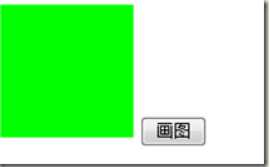
<script type="text/javascript"> function draw() { var c = document.getElementById("cancas"); var cxt = c.getContext("2d"); //红色区域,及其坐标 cxt.fillStyle = "rgb(240,0,0)"; cxt.fillRect(50, 50, 160, 160); //在红色区域上面 添加一个灰色的区域,并且设置 透明度为 0.6 cxt.fillStyle = "rgba(100, 100, 100, 0.6)"; cxt.fillRect(30, 30, 200, 200); //设置在最外面有一个绿色的只有边框的矩形 cxt.strokeStyle = "#00ff00"; cxt.lineWidth = 5; //设置边框的宽度为 5 //最后去掉 这个图形的中心。 cxt.strokeRect(30, 30, 200, 200); cxt.clearRect(80, 80, 100, 100); } </script>
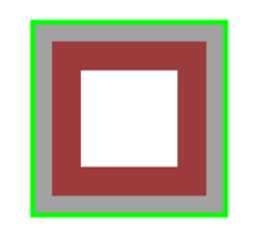
效果图
<body>
<canvas id="myCanvas" width="570" height="570"
style="border:2px solid #000000;">
</canvas>
<script>
var c=document.getElementById("myCanvas");
//然后,创建 context 对象:getContext("2d") 对象是内建的 HTML5 对象,
//拥有多种绘制路径、矩形、圆形、字符以及添加图像的方法。
var ctx=c.getContext("2d");
ctx.fillStyle="#FF0000";
// fillRect(x,y,width,height) 方法定义了矩形当前的填充方式。
ctx.fillRect(200,100,300,200);
</script>
</body>
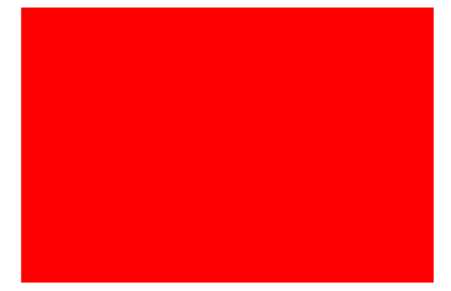
<body>
<canvas id="myCanvas" width="570" height="570"
style="border:2px solid #000000;">
</canvas>
<script>
var c=document.getElementById("myCanvas");
//然后,创建 context 对象:getContext("2d") 对象是内建的 HTML5 对象,
//拥有多种绘制路径、矩形、圆形、字符以及添加图像的方法。
var ctx=c.getContext("2d");
//开始坐标
ctx.moveTo(100,100);
//结束坐标
ctx.lineTo(200,100);
ctx.strokeStyle="blue";
ctx.stroke();
</script>
</body>
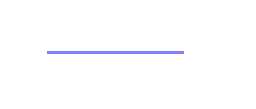
<body>
<canvas id="myCanvas" width="570" height="570"
style="border:2px solid #000000;">
</canvas>
<script>
var c=document.getElementById("myCanvas");
//然后,创建 context 对象:getContext("2d") 对象是内建的 HTML5 对象,
//拥有多种绘制路径、矩形、圆形、字符以及添加图像的方法。
var ctx=c.getContext("2d");
ctx.fillStyle="red";
ctx.beginPath();
ctx.arc(70,18,15,0,2*Math.PI,true);
//画布的左上角坐标为0,0
// x:圆心在x轴上的坐标
// y:圆心在y轴上的坐标
// r:半径长度
// sAngle:起始角度,圆心平行的右端为0度
// eAngle:结束角度
//counterclockwise 可选。规定应该逆时针还是顺时针绘图。False = 顺时针,true = 逆时针。
//注意:Math.PI表示180°,画圆的方向是顺时针
ctx.closePath();
ctx.fill();
</script>
</body>

<body>
<canvas id="myCanvas" width="570" height="570"
style="border:2px solid #000000;">
</canvas>
<script>
var c=document.getElementById("myCanvas");
//然后,创建 context 对象:getContext("2d") 对象是内建的 HTML5 对象,
//拥有多种绘制路径、矩形、圆形、字符以及添加图像的方法。
var ctx=c.getContext("2d");
ctx.font="30px 微软雅黑";
//fillText(text,x,y) - 在 canvas 上绘制实心的文本
ctx.fillText("Hello World",100,100);
//strokeText(text,x,y) - 在 canvas 上绘制空心的文本
ctx.strokeText("Hello World",100,200);
//第一个属性是文字内容,第二个第三个属性是距离x ,y 轴的距离
</script>
</body>

<body>
<canvas id="myCanvas" width="570" height="570"
style="border:2px solid #000000;">
</canvas>
<script>
var c=document.getElementById("myCanvas");
//然后,创建 context 对象:getContext("2d") 对象是内建的 HTML5 对象,
//拥有多种绘制路径、矩形、圆形、字符以及添加图像的方法。
var ctx=c.getContext("2d");
var grd=ctx.createLinearGradient(0,0,175,50);
grd.addColorStop(0,"#FF0000");
grd.addColorStop(0.5,"#00FF00");
grd.addColorStop(1,"black");
//范围为0-1,中间数字随便用用
ctx.fillStyle=grd;
ctx.fillRect(0,0,175,50);
</script>
</body>

<body>
<canvas id="myCanvas" width="570" height="570"
style="border:2px solid #000000;">
</canvas>
<script>
var c=document.getElementById("myCanvas");
//然后,创建 context 对象:getContext("2d") 对象是内建的 HTML5 对象,
//拥有多种绘制路径、矩形、圆形、字符以及添加图像的方法。
var context=c.getContext("2d");
context.fillStyle="red";
context.fillRect(0,0,250,100)
context.transform(1,0.5,-0.5,1,80,10);
context.fillStyle="orange";
context.fillRect(0,0,250,100);
context.transform(1,0.5,-0.5,1,80,10);
context.fillStyle="yellow";
context.fillRect(0,0,250,100);
context.transform(1,0.5,-0.5,1,80,10);
context.fillStyle="green";
context.fillRect(0,0,250,100);
context.transform(1,0.5,-0.5,1,80,10);
context.fillStyle="aliceblue";
context.fillRect(0,0,250,100);
context.transform(1,0.5,-0.5,1,80,10);
context.fillStyle="blue";
context.fillRect(0,0,250,100);
context.transform(1,0.5,-0.5,1,80,10);
context.fillStyle="darkmagenta";
context.fillRect(0,0,250,100);
/* a 水平缩放绘图。
b 水平倾斜绘图。
c 垂直倾斜绘图。
d 垂直缩放绘图。
e 水平移动绘图。
f 垂直移动绘图。*/
</script>
</body>

<body> <canvas id="canvas" width="300px" height="300px" style="border: 1px solid"></canvas> <script> var canvas=document.getElementById("canvas"); var ctx=canvas.getContext("2d"); ctx.beginPath(); // 两个大圆相交 ctx.fillStyle="white"; ctx.arc(150,150,150,0,180*Math.PI/180,false); ctx.fill(); ctx.stroke(); ctx.closePath(); ctx.beginPath(); ctx.fillStyle="black"; ctx.arc(150,150,150,0,180*Math.PI/180,true); ctx.fill(); ctx.stroke(); ctx.closePath(); //两个小圆 ctx.beginPath(); //ctx.restore(90*Math.PI/180); //返回之前保存过的路径状态和属性。 ctx.fillStyle="black"; ctx.arc(76,150,75,0,180*Math.PI/180); ctx.fill(); ctx.stroke(); ctx.closePath(); ctx.beginPath(); // ctx.restore(90*Math.PI/180); //返回之前保存过的路径状态和属性。 ctx.fillStyle="white"; ctx.arc(76,150,20,0,360*Math.PI/180); ctx.fill(); ctx.stroke(); ctx.closePath(); ctx.beginPath(); ctx.fillStyle="white"; ctx.arc(227,150,75,0,180*Math.PI/180,true); ctx.fill(); ctx.stroke(); ctx.closePath(); ctx.beginPath(); ctx.fillStyle="black"; ctx.arc(227,150,20,0,360*Math.PI/180); ctx.fill(); ctx.stroke(); ctx.closePath(); </script> </body>
//自己插入代码,看看是什么东西
杨辉三角
/* 1 1 1 121 2 2 12321 3 3 1234321 4 4 123454321 5 5*/ for (var i=1;i<=10;i++){ for(var j=1;j<=5-i;j++){ document.write(" ") } //递增 num=1; for (var k=1;k<=i;k++){ document.write(num) num++ } //递减 num -=2; for(var l=1;l<=i-1;l++){ document.write(num) num-- } document.write("<br>") }
function Person(name,age){ this.name=name; this.age=age; this.say=function(content){ //在类中,访问类的自身的属性,必须使用this.属性调用 alert("我叫"+this.name+",今年"+this.age+"岁啦!我说了一句话:"+content) } }
//通过赋值打印
//var arr=new Array();
var zhangsan=new Person("张三",18);
//zhangsan.say("哈哈哈");
var lisi=new Person("李四",24);//可以在后面赋值也可以!!后面赋值会覆盖前面
lisi.name="李武";
lisi.age=25;
//lisi.say("张三白痴");
①:constructor:返回当前对象的构造函数。
>>>zhangsan.constructor==Person
②:instanceof:检测一个对象,是不是一个类的实例
>>>lisi instanceof Person √ lisi是通过Person类new出的
>>>lisi instanceof Object √ 所有对象都是Object的实例
>>>Person instanceof Object √函数本身也是对象

2:通过“类名.属性”。“类名.方法”声明的属性和方法。称为静态属性,静态方法
也叫类属性和类方法
类属性/类方法,是属于类的(属于构造函数)
通过"类名.属性名"调用
3 成员属性是属于实例化出的对象的,只能使用对象调用。
静态属性是属于构造函数的,只能使用类名调用
[私有属性和私有方法]
4 在构造函数中,使用var声明的变量,属于私有属性;
在构造函数中,使用function声明的函数,称为私有方法
function Person(){
var num=1;//私有属性
function func(){}//私有方法
}
私有属性跟私有方法的作用域,只鞥在构造函数内容有效,即,只能在构造函数内部使用;
在构造函数外部,无论使用对象名还是类名都无法调用。
function Person(name){ this.name=name;//声明成员属性, var sex="男";//私有属性 this.sayTime=function(){ alert("我说了当前时间是"+getTime()); } this.writeTime=function(){ alert("我写了当前时间是"+getTime()); } function getTime(){//私有方法 return new Data(); } } var zhangsan=new Person("张三") zhangsan.age=14;//追加成员属性 /*alert(zhangsan.name) alert(Person.name)*/ /*alert(zhangsan.age);*///调用成员属性 Person.count="60亿";//声明静态属性 console.log(Person.count);//调用静态属性 var lisi=new Person("李四"); console.log(lisi.count)//Undefined静态属性是属于类的,只能由类名调用 console.log(lisi.count);//undefined 静态属性时属于类的,只能用类名调用 console.log(lisi.sex); console.log(Person.count);
谁最终调用函数,this就指向谁
①:this指上谁,不应该考虑函数在哪里声明,而应该考虑函数在哪里调用!
②:this指向的永远是对象,而不可能是函数
③:this指向的对象,叫做函数的上下文context,也叫函数的调用者。
function func(){
console.log(this);
}
func();//指向window
①:通过函数名()调用的,this永远指向window
举个栗子:
function func(){
console.log(this);
}
func();
function func1(){
console.log(this);
}
func1();
// ①:通过函数名()调用的,this永远指向window func();

②:通过对象.方法调用的,this指向这个对象
// ②:通过对象.方法调用的,this指向这个对象 //狭义对象 var obj={ name:"zhangsan", func:func } obj.func()
③:函数作为数组中的一个元素,用数组下标调用的,this指向这个数组
eg: var arr=[1,2,3,func,4,5,6]; arr[3]();

④:函数作为window内置函数的回调函数使用,this指向window
setTimeout(function(){ func(); },1000); // ④:函数作为window内置函数的回调函数使用,this指向window setTimeout(func,1000)//指向window
⑤:函数作为构造函数,使用new关键字调用,函数指向新的new出的对象
var obj1=new func()

eg: var obj1={ name:"obj1", arr:[func,1,{name:"obj2",func:func},3,4] }
//下面两个例子分别指向谁 obj1.arr[0](); setTimeout(obj1.arr[0],2000);
第一个显而易见,符合第三条
//最终调用者是数组,this->obj.arr
第二个例子里面的
obj1.arr[0]仅仅是取到数组中的第一个值,并不是指向数组,最终的调用者是setTimeout
直截了当的写法应该是
setTimeout(
func,2000);
最终指向WINDOW
var fullname = ‘John Doe‘; var obj = { fullname: ‘Colin Ihrig‘, prop: { fullname: ‘Aurelio De Rosa‘, getFullname: function() { return this.fullname; } } }; console.log(obj.prop.getFullname());
//可以看出最终的调用者是; // 函数的最终调用者 obj.prop
最终的指向结果是指向obj。prop这个数组
var test = obj.prop.getFullname; console.log(test());
//显而易见使用函数()进行的调用 // 函数的最终调用者 test() this-> window
obj.func = obj.prop.getFullname; console.log(obj.func()); // 函数最终调用者是obj
//很明显符合对现象.方法调用指向这个obj对象
var arr = [obj.prop.getFullname,1,2]; arr.fullname = "JiangHao"; console.log(arr[0]()); // 函数最终调用者数组
【 __proto__与prototype】
1.prototype:函数的原型对象
①:只有函数才有prototype,而且所有函数必有prototype
②:prototype本身也是一个对象!
③:prototype指上了当前函数所在的引用地址!
2.__proto__:对象的原型!
①:只有对象才有__proto__,而且所有对象必有__proto__
②:__proto__也是一个对象,所以也有自己的__proto__,顺着这条线向上找的顺序,就是原型链。
③:函数,数组都是对象,都有自己的__proto__
3 实例化一个类,拿到对象的原理?
实例化一个类的时候,实际上是将新对象的__proto__,指向构造函数所在的prototype
也就是说 zhangsan.__proto__==Person.prototype √
4 所有对象的__proto__延原型链向上查找,都将指向Object的prototype。
Object的prototype的原型,指向null
【原型链的指向问题】
研究原型链的指向,就是要研究各种特殊对象的__proto__的指向问题。
1.通过构造函数,new出的对象,新对象的__proto__指向构造函数的prototype
2函数的__proto__,指向Function()的prototype
3函数prototype的__proto__指向Object的prototype
(直接使用{}字面量声明,或使用new Object拿到的对象的__proto__直接指向Object的prototype)
4 Object的prototype的__proto__,指向null
(Object作为一个特殊函数,他的__proto__指向Function()的prototype)
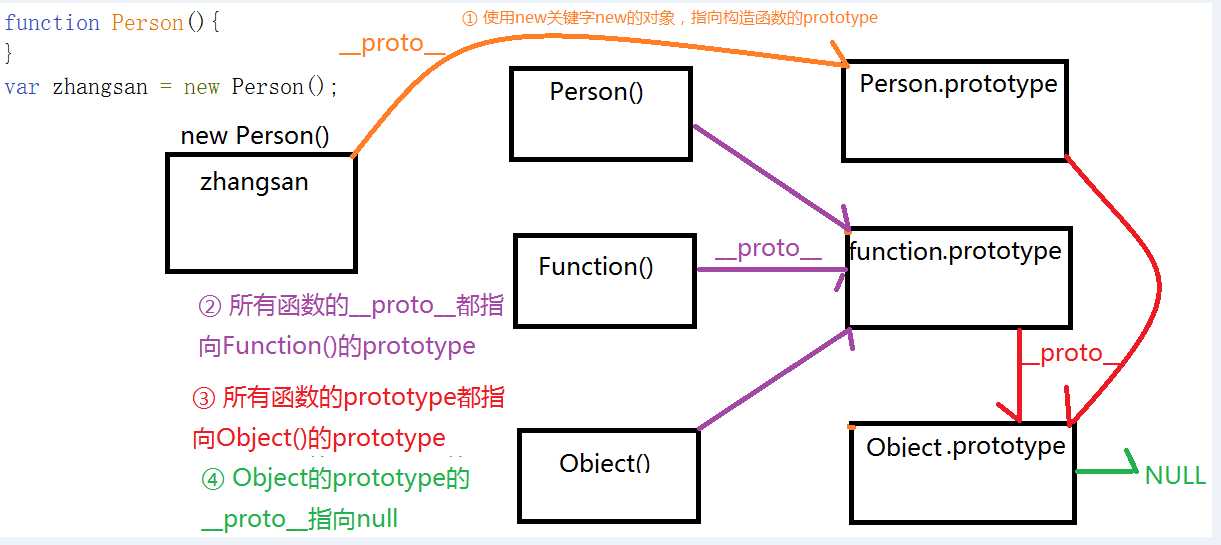
标签:设置 属性 image 插入代码 接受 下标 中心 font gen
原文地址:http://www.cnblogs.com/scd903686521/p/7668106.html